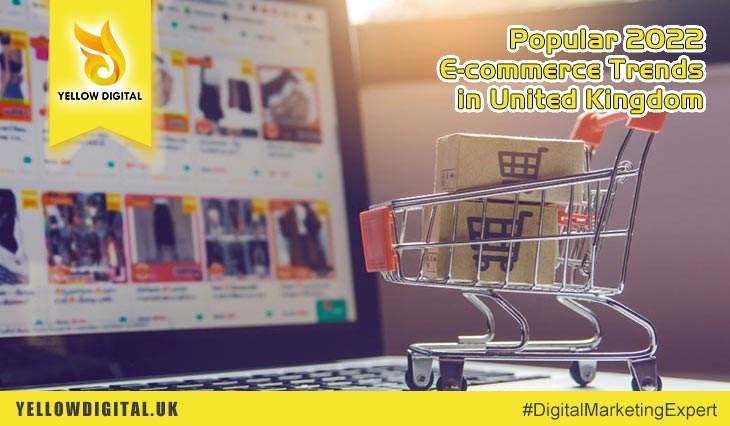We all know that the world of e-commerce is the future of shopping.
Global e-commerce sales are forecast to reach £5.74 trillion by 2023. In the current era, more and more companies are experimenting with their e-commerce platforms to deliver what their consumers want. And since demand changes quickly, supply needs to adapt to that change smoothly.
E-commerce platforms don’t have to be standardized and boring, because who likes that?
Nobody has the time to scroll down an unexciting and repetitive e-commerce page. More importantly, why be boring when YELLOW DIGITAL can make your e-commerce platform more interactive and creative!
If you’re looking to grow your e-commerce business in the UK, check out the latest trends for 2022 below.
Apply them to your business if you haven’t already to stay ahead of the curve with Yellow Digital!
1. Emphasis on Sustainability
Both consumers and businesses will prioritize sustainability in the coming year. Focusing on the environmental impact of selling and buying products and services will play an important role in e-commerce.
Millennials are more aware of sustainability than ever! Since they are the most important target group with increasing purchasing power, companies will benefit from environmental friendliness in the long term.
Many companies have started to offer environmentally friendly packaging, use raw materials, offer rewards, recycle and reuse the products and services. The Body Shop offers sustainable packaging by using recycled plastic for its product packaging. TOMS uses sustainable, recyclable and vegan materials for its shoes and even its shoe boxes.
2. User-Generated Content
User-generated content (UGC) is the next big thing for e-commerce companies. Customers who share pictures or videos of a brand’s products or services on their social media accounts can be beneficial to the businesses. It creates enthusiasm among consumers and increases brand awareness. It also reflects authenticity rather than celebrities and models endorsing the products and services.
About 68% of Millennials say UGC is seen as a worthy indicator to determine the quality of a brand’s product or service. Sharing pictures of customers using the products on the website is another way to showcase UGC.
3. Influencer Marketing
Influencer marketing has developed into a game changer in recent years. It’s a popular approach that is used by many companies, especially on Instagram. Many of us search Instagram for suggestions from our favorite influencers before making the final purchase decision.
While popular, choosing the right influencer for your business and target market is key. Micro-influencers tend to have a bigger impact on consumers because people are able to identify with influencers. Micro-influencers usually have 1,000 10,000 followers on their Instagram and are also more budget-friendly.
Every other brand is now using this strategy to sell their product or service, and it will expand later this year!
4. Customized Shopping Experiences
The personalization of products and shopping experiences is another increasing e-commerce trend in 2022. Customers appreciate it when the products and services are tailored to them. You feel connected to the brand and increase brand loyalty. Personalization of products and services increases the likelihood of buyers buying this brand by 80%. Wouldn’t you prefer to buy something bespoke rather than something everyone has?
Nike is currently dominating the market with a bespoke shopping experience for its consumers by offering product customization in-store or digitally. Apple also offers its consumers an individual shopping experience. It provides an engraving service when a customer purchases an Apple product online.
5. Integration of AR technology
Using this powerful technology in the e-commerce platform can transform and improve the overall shopping experience. Gone are the days when online stores faced challenges in selling their products because consumers couldn’t see the product before purchasing it.
AR eliminates these challenges by allowing consumers to see the products virtually before purchasing them. It also increases excitement and attracts the consumer to visit your physical store. Wouldn’t you prefer to see the actual product before buying?
Many companies like Ikea and Amazon are successfully using this technology to help their customers. Ikea is using AR to enable consumers to visualize what their chosen furniture will look like in their home. Similarly, Amazon also uses AR to enable customers to visualize what their chosen product will look like in their own living space.
6. Diverse Marketplaces
So far, many sellers have only used platforms such as Shopify or Etsy. However, they have recognized that having different marketplaces to sell their products and services is more beneficial for both consumers and businesses. It enables sellers to grow their business and reach more consumers.
The most popular e-commerce marketplaces include Amazon, eBay, Instagram, and Facebook.
Instagram, and Facebook have quickly become a popular e-commerce platform for online shopping among millennials in the UK and around the world. The good thing is that both Facebook and Instagram offer a shopping feature that allows businesses to link their product catalog, and that’s it! You can start Instagram shopping by adding product tags in the posts and stories so that the user can view the products in different settings.
If you are seeking to expand your business in United Kingdom by integrating some of these trends, drop us an email at info@yellowdigital.uk. Yellow Digital is here to assist you.
#ecommerce #digitalmarketing

